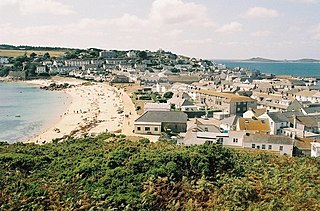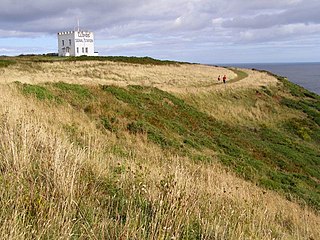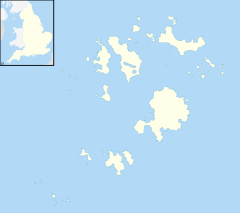The Isle of Man has an extensive communications infrastructure consisting of telephone cables, submarine cables, and an array of television and mobile phone transmitters and towers.

Transatlantic telegraph cables were undersea cables running under the Atlantic Ocean for telegraph communications. Telegraphy is now an obsolete form of communication, and the cables have long since been decommissioned, but telephone and data are still carried on other transatlantic telecommunications cables. The first cable was laid in the 1850s from Valentia Island off the west coast of Ireland to Bay of Bulls, Trinity Bay, Newfoundland. The first communications occurred on August 16th 1858, but the line speed was poor, and efforts to improve it caused the cable to fail after three weeks.

St Mary's is the largest and most populous island of the Isles of Scilly, an archipelago off the southwest coast of Cornwall in England, United Kingdom.

Hugh Town is the largest settlement on the Isles of Scilly and its administrative centre. The town is situated on the island of St Mary's, the largest and most populous island in the archipelago, and is located on a narrow isthmus which joins the peninsula known as the Garrison with the rest of the island.

Porthcurno is a small village covering a small valley and beach on the south coast of Cornwall, England in the United Kingdom. It is the main settlement in a civil and an ecclesiastical parish, both named St Levan, which comprise Porthcurno, diminutive St Levan itself, Trethewey and Treen.

St Ives is a parliamentary constituency covering the western end of Cornwall and the Isles of Scilly. The constituency has been represented in the House of Commons of the UK Parliament since 2015 by Derek Thomas, a Conservative MP.

The Isles of Scilly Steamship Company (ISSC) operates the principal shipping service from Penzance, in Cornwall, to the Isles of Scilly, located 28 miles (45 km) to the southwest. It provides a year-round cargo service together with a seasonal passenger service in summer. The name of the company's principal ferry, the Scillonian III, is perhaps better known than that of the company itself.

St Mary's Airport or Isles of Scilly Airport is an airport located 1 nautical mile east of Hugh Town on St Mary's in the Isles of Scilly, to the south west of Cornwall, UK. It is the only airport serving the Isles of Scilly, handling all air traffic to and from the Islands. The airport is owned by the Duchy of Cornwall and currently is operated by the Council of the Isles of Scilly.

RMV Scillonian III is a passenger ship based at Penzance in Cornwall, England, United Kingdom, run by the Isles of Scilly Steamship Company. She operates the principal ferry service to the Isles of Scilly and is one of only three ships in the world still carrying the status of Royal Mail Ship.

Penzance Heliport is located 0.6 NM northeast of Penzance, Cornwall. The heliport hosts scheduled flights to the Isles of Scilly, with a connection to the railway network at Penzance railway station by a special bus service. The original heliport had a single concrete landing pad, which was 30 m × 30 m, inside a 373 m × 45 m grass strip, 08/26.
The West Cornwall Steam Ship Company was established in 1870 to operate ferry services between Penzance, Cornwall, and the Isles of Scilly. It became the West Cornwall Steamship Company in 1907 and was wound up in 1917.

Australia was a relatively early adopter of electrical telegraph technology in the middle of the nineteenth century, despite its low population densities and the difficult conditions sometimes encountered in laying lines. From 1858 onwards, the major capitals were progressively linked, culminating in the addition of Perth in 1877. Australia was linked to the rest of the world for the first time in 1872, through the Overland Telegraph which ran some 3,200 kilometres (2,000 mi) from Adelaide through to Darwin. The network continued to expand in size and sophistication until 1959 and in heavy usage until 1945, after which time telephone usage began to erode public patronage of telegraphy services. The final publicly provided telegraphy service was closed in 1993.

Bass Point is a headland on the coast of Cornwall, England. It is at the southern tip of the Lizard peninsula, in the civil parish of Landewednack. The headland was a communications centre during the Victorian era, with the Lloyds Signal Station, opened in 1872 for shore to ship communications, and Marconi's experiments with wireless at the Lizard Wireless Station.
Tregarthen's Hotel is a hotel in Hugh Town on St Mary's in the Isles of Scilly.
PS Earl of Arran was a passenger vessel operated by the Ardrossan Steamboat Company from 1860 to 1871 and the West Cornwall Steam Ship Company from 1871 to 1872
SS Lady of the Isles was a passenger vessel built by Harvey and Company, Hayle for the West Cornwall Steam Ship Company in 1875.
SS Lyonesse was a passenger vessel built for the West Cornwall Steam Ship Company in 1875.

Coastguard’s Lookout Tower, now known as Telegraph Tower, is a Grade II listed structure built around 1814-16 on St Mary's, Isles of Scilly as a Signal station for the Admiralty.

In the nineteenth century, the United Kingdom of Great Britain and Ireland had the world's first commercial telegraph company. British telegraphy dominated international telecommunications well into the twentieth. Telegraphy is the sending of textual messages by human operators using symbolic codes. Electrical telegraphy used conducting wires to send messages, often incorporating a telegram service to deliver the telegraphed communication from the telegraph office. This is distinct from optical telegraphy that preceded it and the radiotelegraphy that followed. Though Francis Ronalds first demonstrated a working telegraph over a substantial distance in 1816, he was unable to put it into practical use. Starting in 1836, William Fothergill Cooke, with the scientific assistance of Charles Wheatstone, developed the Cooke and Wheatstone telegraph. The needle telegraph instrument suggested by Wheatstone, the battery invented by John Frederic Daniell, and the relay invented by Edward Davy were important components of this system.















